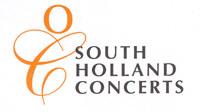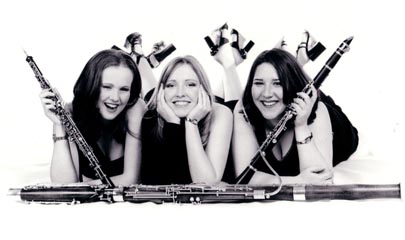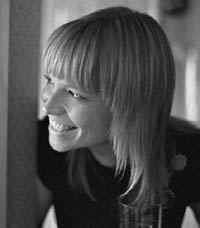|
PROGRAMME
THE ARRIVAL OF THE QUEEN OF SHEBA HANDEL (1685-1759) (arr.Thorneloe)
Handel's oratorio 'Solomon' (from which this famously energetic
piece is taken) was first performed in March 1749. Handel demanded
huge forces for his day in order to perform this oratorio - over
a hundred players and singers. The work is not a sacred piece
in the truest sense, but a dramatic pageant. It contains music
depicting passionate ceremonial which alternates with passages
of sweet lyricism. It is said of this oratorio's glorious Act
One, that "Solomon and his Queen appear to do little on stage
but exchange increasingly sensuous blandishments." Perhaps so.
But Handel displays in this score some of his finest instrumental
writing, clearly evident here in this Trio arrangement depicting
the Queen's noble entrance,
DIVERTIMENTO no. 4 in Bb MOZART (1756-1791) (arr. Oubradous)
Allegro
Larghetto
Minuet and Trio
Adagio
Rondo - Allegro
This arrangement, from a Divertimento for three basset-horns (a
curiously shaped eighteenth century instrument and member of the
clarinet family), is one of a set of five pieces written during
1783/4 - a period of the composer's finest works. There is a degree
of uncertainty concerning which of Mozart's works were originally
conceived for these now rare instruments. They are scored, for
example, in his famous Requiem Mass. Even the first movement of
Mozart's famous Clarinet Concerto (K.622) was first drafted in
the key of G for an instrument commonly known as the 'basset-clarinet'
before he transcribed it into its present key for the instrument
we know today. This highly successful arrangement for oboe, clarinet
and bassoon conveys all of the buoyancy and light-heartedness
of the original. We are reminded that these Divertimenti (along
with Mozart's many Serenades for wind instruments) were never
conceived as concert pieces. They were envisaged more as casual
entertainment. As one musician once described them, "This was
written as music to eat by!"
SUITE no.3 in C Major BACH (1685-1750) (arr. Martin Gatt)
Bourrée 1 and Bourrée 2
Martin Gatt is well known to music lovers as one of this county's
finest bassoonists. One-time principal bassoon with the London
Philharmonic, the London Symphony Orchestra and the English Chamber
Orchestra, he has been an international soloist and a teacher
of distinction. Gatt's splendid arrangements of movements from
Bach's Cello Suites have been some of his most successful additions
to the bassoon's repertoire and are frequently performed by bassoonists.
FIVE PIECES FOR CLARINET GORDON JACOB (1895-1984)
1. Preamble
3. Homage to JSB
Gordon Jacob is another composer to whom modern wind and brass
players are especially grateful. His powerful concertos written
for almost every woodwind and brass instrument are all technically
challenging and yet full of imagination. However, Jacob's music
should have a wider appeal. His huge catalogue of compositions
covers almost every genre from symphonies to vocal works and chamber
music. However, recordings and performances of his music are few.
A pity. Jacob was born in London, and studied at the Royal College
of Music under Vaughan-Williams, Parry and Sir Adrian Boult. He
subsequently returned to RCM where he was professor of composition
for many years. These Five Pieces for solo clarinet were written
in 1972 for the clarinettist Georgina Dobrée. The searching initial
Preamble is followed by an unmistakable Homage to J.S.Bach. If
the ingenuity of these short pieces appeals to you, listen out
for Gordon Jacob's highly acclaimed Divertimento for Harmonica
and String Quartet, composed for the famous harmonica player Tommy
Reilly, and later recorded by him.
CINQ PIECES EN TRIO JACQUES IBERT (1890-1962)
Allegro Vivo
Andantino
Allegro assai
Andante
Allegro quasi marziale
Jacques Ibert, born in Paris in 1890, studied at the Paris Conservatoire
and was a winner of the coveted Prix de Rome in 1919. He subsequently
worked as a highly respected director of the French Academy in
Rome for over twenty years. Ibert's music is mainly neo-classical
in style, though he is versatile as a composer and his music is
often difficult to categorise. Much influenced by Debussy and
Poulenc (and even Stravinsky in many of his works) he was particularly
adept at writing for wind instruments. His style - original, buoyant
and fun - is perhaps captured typically in the delightful Three
Short Pieces (for Wind Quintet) of 1930 and in his popular and
energetic Concertino for Saxophone and 11 instruments with its
witty jazz influences. The present 5 Pieces for Trio dates from
1935, and ideas as varied as plainsong, dance music and counterpoint
are each developed within these short, well-written movements
in a true neo-classical style.
TRIOLET in Eb RICHARD H. WALTHEW (1872-1951)
Allegro Comodo
Lento Poco Appassionato
Intermerzzo - Allegretto
Vivace
The term Triolet normally describes a particular type of verse
structure in the composition of a poem. Here, Walthew is using
the term to imply a 'trio in miniature'. This little-known English
composer (a pianist and conductor) wrote a great many chamber
works of some distinction and which were performed in London at
the composer's South Place Orchestra concerts. Walthew's style
is richly romantic and somewhat reminiscent of Edward Elgar. These
four movements are picturesque, conjuring up images of the sea
and fanciful dances with tight rhythm and full-bodied harmonies.
CHANSON DE MATIN ELGAR (1857-1934) (arr. John Newhill)
When a simple, unforgettable melody is so well known that its
original origins have long been forgotten, arrangers often do
us great service by breathing fresh impetus into the music and
giving to it a new life. Elgar's Chanson de Matin and Chanson
de Nuit are two such pieces. They were published for violin and
piano in 1897 and rearranged for orchestra two years later. Since
then, these remarkable tunes have been transcribed for every conceivable
instrument and ensemble! Edward Elgar was born in a village outside
Worcester and his father was an organist and music shop owner.
The life story of this esteemed composer is now legendary (thanks
partly to a remarkable TV documentary made many years ago). The
significance of this famous Edwardian's music - even his miniature
pieces - can hardly be overstated. The inescapable beauty of the
melodic line in Chanson de Matin is set here with warmth and charm
in this Trio arrangement. It allows each wind instrument to sing
with an expressive, natural tone.
FIVE TRIO SONATA MOVEMENTS HANDEL (arr. Voxman and Block)
Affecttuoso (Andante)
Gavotte (Allegro)
Air (Andante)
Minuet
March
The Trio Sonata was one of the most important forms of chamber
music in the Baroque period. Handel wrote many sets of Trio Sonatas
and each sonata is scored for three instrumental voices. Conforming
to the accepted pattern of the seventeenth and early eighteenth
centuries, Handel wrote for two upper instruments (normally two
violins) and a 'figured' bass line (cello). This figuration on
the bass line was often used by an additional (but optional) keyboard
player to add embellishment and interest to the ensemble. The
use of alternative instruments in Trio Sonata movements is perfectly
authentic, and there is much evidence of woodwind instruments
being employed in place of strings. In this arrangement (a selection
of movements from different sonatas), the oboe and clarinet play
the two treble lines and provide a pleasing contrast in texture.
SONATA FOR SOLO OBOE in G Minor (1st Movement) C P E BACH
(1714-1788)
Carl Philip Emanuel Bach, the third son of J S Bach was born in
Weimar in Germany. For eleven years he was employed in the court
of Frederick the Great and was an excellent keyboard player. Mozart
championed his compositional style saying of him: "He is the parent
and we are the children." C P E Bach's importance as a composer
stems from his imaginative development of style that led to the
birth of the symphony. The instrumental sonata also assumed a
very different style to that of his father, with less emphasis
on the dance-suite and formal fugue. This Sonata for solo oboe
is typical of the new style favoured in the mid eighteenth century.
Selection from CENTURY DANCES CECILIA McDOWALL (b. 1951)
Allemande
Minuet
Mazurka
Tango
Last Dance
With Cecilia McDowall's ability to appeal readily to audiences
of all ages with her music, it is no surprise that her compositions
are currently high on the popularity list with young instrumental
students. Her style is readily accessible, fun to play and rewarding
to listen to. However, McDowall is not just an 'educational' composer.
Her work has been commissioned by many of the most prestigious
orchestras and choirs here and abroad, and her music can regularly
be heard on BBC Radio and TV. Listen out for her Four Shakespeare
Songs for soprano and piano, and her beautiful and strikingly
original setting of the Magnificat - both available on CD.
Century Dances received its first performance in December 2005
and was commissioned by The Thorne Trio. The dances come from
the eighteenth century to the present day, and each has very different
characteristics. The Allemande (which was frequently an introductory
movement in the Baroque dance-suite) ushers in the work with flourishes
and trills. The following Minuet (subtitled Ghost Dance) is distant
and fragmented. The Mazurka (a Polish dance - much favoured by
Chopin) is expansive and stately, and is succeeded by the dark
intensity of the Tango. Finally, Last Dance rocks the suite to
an exuberant conclusion. (We thank The Thorne Trio for material
on Century Dances from which the above note has been compiled)
DIVERTIMENTO ON FOLK SONGS STEFAN DE HAAN (b.1921)
O Enemy - Allego, tempo di Marcia
In the Wild Forest - Andantino
Allegro ma non troppo
Stefan de Haan is an Englishman well known as a distinguished
bassoonist, composer and writer. His music sparkles with wit and
originality, and wind players especially enjoy his sympathetic
understanding of these instruments for which he writes so well.
These fantasias hide well known tunes and combine much skilful
instrumentation with delicate humour and delightful nuances.
Programme Notes by Peter Case for South Holland
Concerts ©2006
|


